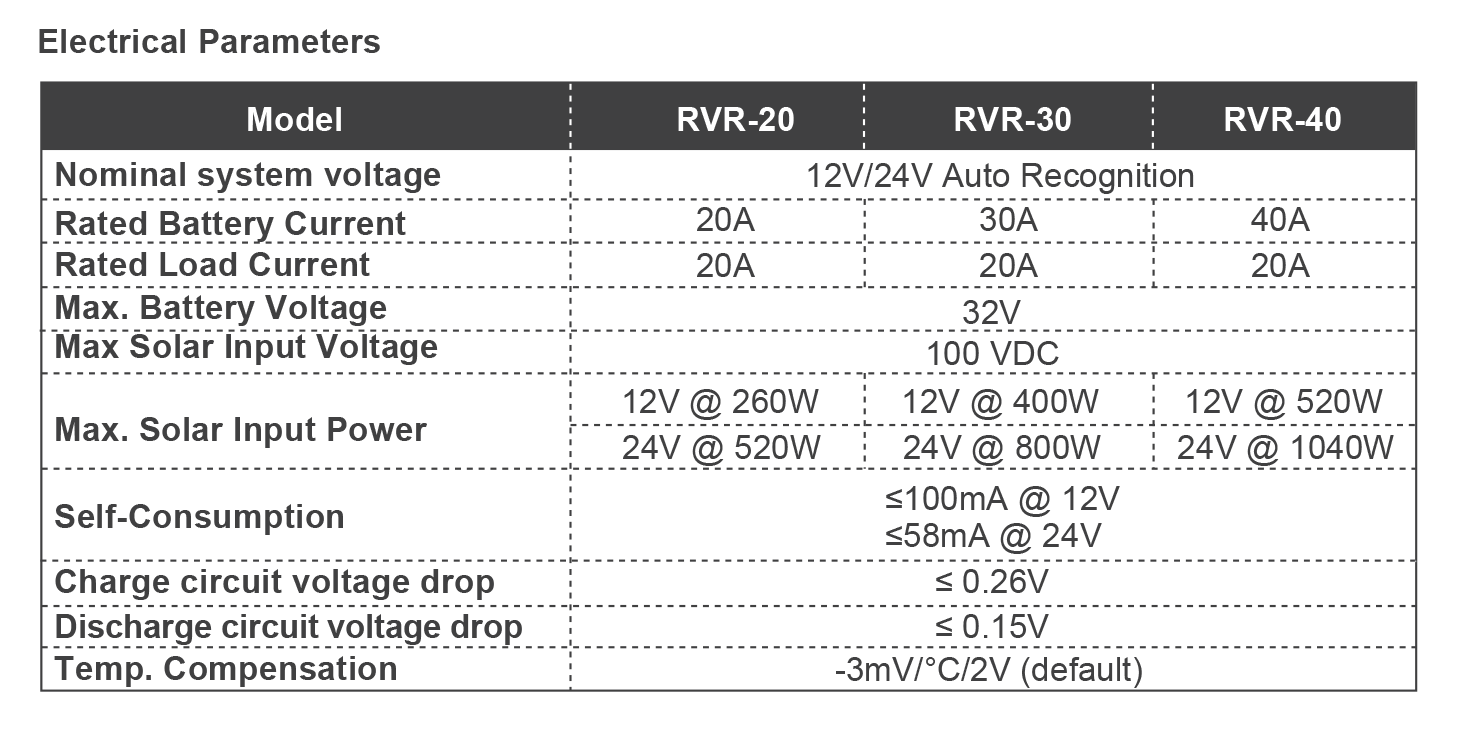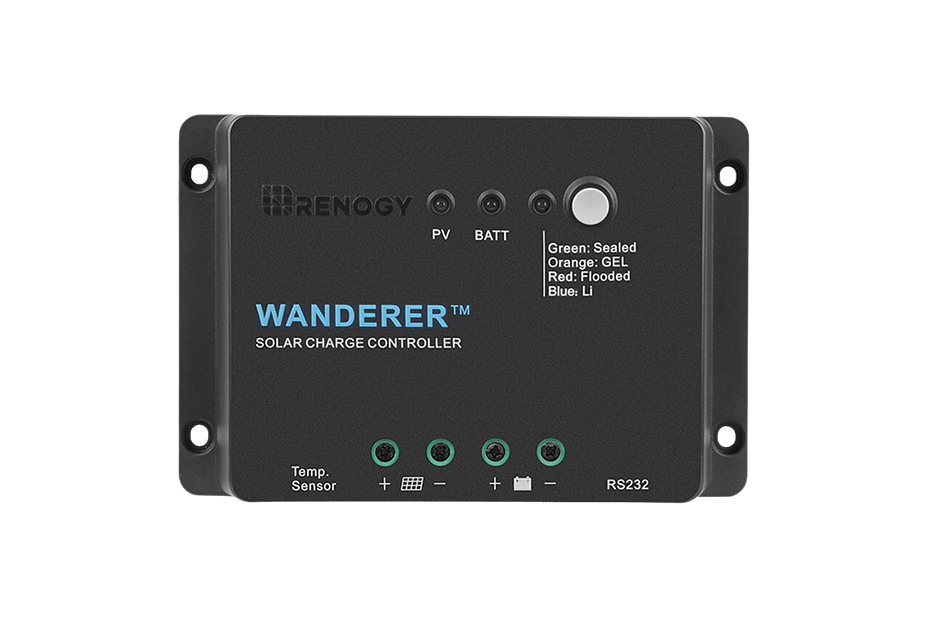Solar panels generate a voltage and current that vary widely depending on the sunshine available. But a battery needs a steady electricity supply at the correct voltage and current to charge appropriately. A charge controller takes the solar panel’s electricity and adjusts the voltage and current to best charge the battery. A solar charge controller inputs the variable power coming from the solar panels and turns it into a steady flow to charge the battery. A charge controller also knows when the battery is fully charged, reducing or stopping the electricity flow.
MPPT or PWM
In 2023, two main solar charge controller types are in wide use: the maximum power point tracking(MPPT) type and the pulse width modulation(PWM) type.
Of the two types, the MPPT controller does a much better job of extracting the maximum power from the solar panels over a broader range of sunlight conditions and solar panel types. When the sun shines brightly and the system components are well-matched, a PWM controller system is about as efficient as an MPPT system. To learn more about how an MPPT controller works, click here.
MPPT Controllers are More Efficient
Besides being more efficient, MPPT controllers are more flexible. They can adapt solar panel output voltages that differ from the nominal battery charging voltages. MPPT controllers are better for higher power systems. They are less efficient than PWM controllers for simple designs with only a few panels.
The main disadvantage of MPPT controllers is their cost. A 30-amp MPPT controller can cost three times as much as a 30-amp PWM controller. This has less impact on the total cost for larger systems.
PWM Controllers are Simple and Tough
Although less efficient than MPPT controllers, PWM controllers are ideal for systems where the electricity made by the solar panel dramatically exceeds the battery drain. It is easy for the controller to keep the battery charged because power is abundant. Since PWM controllers are simpler and more rugged, they can be better for outdoor use or in remote locations.
How to Select a Solar Charge Controller
Features of a Good MPPT Charge Controller
A full-featured MPPT controller has the following:
- Efficiency near 98%,
- 4-stage charging profiles for all battery types,
- Internal protection for over and under voltage and current,
- Remote monitoring.
The controller needs to match the overall system. For example, let’s look at some of the basic specs of a Renogy MPPT controller.

Nominal System Voltage
The nominal system voltage refers to the voltage of the batteries. A suitable controller can auto-select the correct voltage. In this example, the maximum system battery voltage is 32v. You need to use another controller if you have a 48-volt system.
Rated Battery Current
The rated battery current is the maximum amps the controller can deliver to the battery. The controller adjusts the amps depending on the battery’s state of charge. If the battery is low, the controller sends more amps; if the battery has a full charge, the amps are reduced. Different battery types have distinct charging profiles. A good charge controller can sense some of the common types. Some controllers allow the user to program a custom charging profile. Check the charging recommendations for the specific battery you have.
Rated Load Current
The rated load current is the maximum load directly attached to the controller using the accessory terminals. The accessory terminals are not used often. Usually, all system loads are connected to the battery. Many controllers do not have accessory terminals.
Maximum Solar Input Voltage
The maximum solar input voltage is the highest voltage the controller can accept from the connected solar panels. Single solar panels can be rated for 12 or 24, or 48 volts. Remember that connecting panels in series add the volts, and connecting panels in parallel add the amps. Add 25% to the rated solar panel voltage when selecting a controller as a safety factor. Good controllers have internal over-voltage protection. To learn more about matching PV panels to a charge controller, click here.
Maximum Solar Input Power
You may be asking why a 24-volt system can run at double the wattage of a 12-volt system. To understand maximum solar input power, remember that watts = volts times amps. So, for a 12-volt system and a 40-amp controller, the maximum input is 480 watts, rounded in the chart to 520 watts.
Another way to express the first equation is watts divided by volts = amps. So, 400 w divided by 12 v, written another way, 520w/12v = 43.33 amps, close to the rated battery current.
It may not make sense initially, but most solar controllers can run the same maximum current throughout their input voltage range. They are more limited by current than by voltage.
12 Volts vs. 24 Volts
If your vehicle has a 12-volt system, then set up your solar power to run at 12 volts. For systems between 1000 and 5000 watts, 24 volts is a good setup. Note that if you are running a 24-volt system, you can collect 1040 watts vs. 520 watts for a 12-volt system. With the same controller, you can collect twice the power with a 24-volt system compared to a 12-volt one. You will need more solar panels to do this. Remember that solar panels are rated in watts, watts = volts x amps, and the solar power charge controller is current-limited. To learn more about solar panel wiring, watts, volts, and amps, click here.
Self-Consumption
Self-consumption is the power that the controller needs to operate. This is why the controller is not 100% efficient. The charge circuit and discharge circuit voltage drop also refer to the internal workings of the controller.
Temperature Compensation
Finally, the temperature compensation feature accounts for how temperature affects battery charging requirements and fine-tunes the charging profile. Overcharging a hot battery can be dangerous and damage the battery.
Comparison
Let’s compare two MPPT charge controllers; the Victron 100/30 and the Renogy 30A controller.
Victron SolarSmart 100/30 MPPT Charge Controller

Victron is a Dutch company that was started in 1975. They focus on manufacturing products for battery-based systems, including charge controllers, inverters, transformers, batteries, power distribution, and system monitoring and control. All Victron components and solutions are top-shelf and commercial grade. They are used in multiple sectors, including industry, marine, telecom, energy storage, commercial vehicles, backup, and off-grid.
The Victron Smart Solar 100/30 charge controller handles solar panel array voltages up to 100v and outputs 30 amps for 12 and 24-volt battery systems. It is part of a family of controllers with built-in blue tooth connectivity covering various system sizes.
With a complete feature set, it handles all battery types and has robust internal protection against PV reverse polarity, output short circuits, and over-temperature. It has an IP43-certified case, is safety and performance certified across multiple industries, and comes with a 5-year warranty.
Additionally, the controller stores 46 days of the following trends: battery voltage, temperature, and PV volts and amps. In addition to Bluetooth connectivity, the controller has a proprietary serial port to connect to other Victron devices or interface with multiple industry-standard protocols.
The controller has a 4.8 out of 5 global rating on Amazon. A small percentage of bad reviews said that the controller install instructions are not user-friendly. This may not be the controller for a newbie unless you have the patience to read the fine print.
The Victron SmartSolar 100/30 is the perfect controller for the ultimate flexibility, performance, system integration, and monitoring.
Renogy Rover 40A 12/24 MPPT Charge Controller
The company Renogy was founded in 2010 with the mission to provide reliable, DYI-friendly renewable energy products. Their product line includes individual solar power components and complete systems perfectly sized for off-grid and low-footprint living.
The Rover 30A 12/24 charge controller is built mainly for the consumer market. The IP 32 enclosure rating is lower than the Victron. This means the Renogy is less resistant to dust and incidental water splashes than the Victron. Neither device can withstand immersion. Also, the Renogy has a 2-year warranty compared to the Victron 5-year guarantee.
Notably, the Renogy can work as a boost controller, which means it can charge a battery when the PV panel output voltage is less than the battery voltage. The Victron requires that the PV voltage is +5 the battery voltage. It is generally better to have the PV voltage above the battery voltage. To learn more about matching solar panels to charge controllers, click here.
The Rover 30 12/24 is a solid 30 amp, 12-volt/400-watt – 24-volt/800-watt charge controller. It includes all the crucial features for MPPT solar charging:
- 4-stage intelligent charging for all popular battery profiles and programmable custom profiles;
- built-in battery temperature monitoring and compensation;
- internal protection for out-of-spec voltage and amperage for the PV array and the battery; and
- Bluetooth connectivity, Renogy One WIFI energy monitoring, and off-grid smart living center.
Product Reviews
Overall, customers are very happy with the controller. It ranks 4.5 overall in over 1,500 reviews on Amazon. A few people had problems dead on arrival failures, getting the controller to work with third-party PV arrays and batteries, and some difficulties with documentation and customer service.
The real strength of this controller is you can buy it in a kit with a matched set of solar panels. Renogy makes 200-watt and 400-watt solar energy kits that include this controller.
Conclusion
So, what is the best charge controller? It depends on what you want to do. MPPT controllers generate maximum energy in changing conditions. They can adapt to a wide range of PV and battery setups. On the other hand, PWM controllers are simple, rugged, and best for a small set-and-forget type system.
Taking a closer look at two MPPT controllers gives an overview of the available range. Both controllers are full-featured; they offer 4-stage charging, user-programmable battery profiles, temperature compensation, and internal electronic protection.
The Victron is a commercial-grade controller. It is the one to use if you are designing an extensive system and want a complete system overview and control. Victron components are used in top-grade systems across multiple industries worldwide.
The company Renogy is focused on DIY. The Rover 30A 12/24 MPPT Charge Controller is a full-featured consumer-grade controller that is a great choice when used as part of a Renogy solar energy kit, which includes PV panels, a controller, and wiring.
